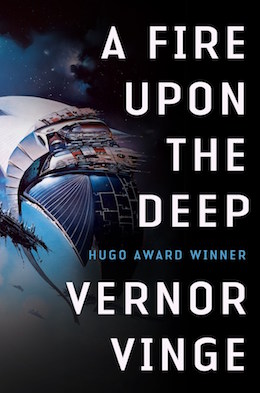It’s not that I think A Fire Upon the Deep is perfect, it’s just that it’s got so much in it. There are lots of books that have fascinating universes, and there are lots of first contact novels, and there are lots of stories with alien civilizations and human civilizations and masses of history. The thing that makes A Fire Upon the Deep so great is that is has all these things and more, and it’s integrated into one thrilling story. It has the playful excitement and scope of pulp adventure together with the level of characterisation of a really good literary work, and lots of the best characters are aliens.
It really is the book that has everything. Galaxy spanning civilizations! Thousands of kinds of aliens! Low bandwidth speculation across lightyears! Low tech development of a medieval planet! Female point of view characters! A universe where computation and FTL travel are physically different in different places! An ancient evil from before the dawn of time and a quest to defeat it! A librarian, a hero, two intelligent pot plants, a brother and sister lost among aliens, and a curious mind split between four bodies. And the stakes keep going up and up.
Vinge makes this complicated novel work by starting with the Blight, the threat at first to a lab full of human scientists at the edge of the Transcend, and then to the whole galaxy. We start close up and small with a freighter full of children escaping, and the threat of the Blight is always relentlessly there, throughout the rest of the book. Whenever a lesser writer would have a man come through the door with a gun, Vinge has the Blight destroy something big—or in one case, some aliens reacting to the Blight destroy something big. The universe is very complicated, and there are braided stories ratcheting along, but the shape of the story is very simple—the swelling threat of the Blight, the treasure at the bottom of the Beyond, the chase and pursuit.
He also keeps it focused down on the characters—Johanna and Jeffri Olnsdot on the planet of the Tines, the Tine Pilgrim with his four bodies, Ravna, the librarian from Sjandra Kei who is the only human working at Relay, and Pham Nuwen, the trader from the Slow Zone with pieces of a god in his head. And because there are two strands of story they drive each other forward—you never leave one strand without wanting more of it, and Vinge keeps up this balance all the way to the climax. Vinge sets us close in, and everything is so fascinating right from the start that it’s easy to get to really care.
This particular kind of fascination is almost unique to science fiction. There’s a universe and the way it works is really weird, and he keeps handing out pieces of it and you keep fitting it together. There are two real stories here, the children on the Tines World, and Ravna and Pham’s rescue attempt. The first has the tines themselves, with their minds and personalities spread across bodies. It also has the development of technology from “dataset”—a child’s computer with a portable web full of information. And there’s the way Samnorsk is this wonderful language of science and opportunity for the tines, and you can get whiplash seeing how it’s a backwater dead end language in the wider universe. In the second story, you have the wider universe with the zones. And there’s the low bandwidth “net of a million lies” where civilizations trade information that is sometimes incomprehensible. There’s the automation that degrades as you move downward. There are the skroderiders, and the tuskleg aliens and the jovians and the Powers that live in the Transcend. All the details build up and draw you in, so that by the end of the book when you come out gasping for breath it’s almost as if you have really been there.
But yet, this is a fight of good against evil, gods and lurking evil, it begins with the metaphor of the mummy’s tomb and ends with a transcendent victory. There’s something of the joy of fantasy in it too. Pham and the skroderiders are canny traders, Vrimini.org wants to make a profit, only Ravna the librarian wants an adventure, a daring rescue, to save the universe. One quest, Blueshell agrees to, but never another! But this is an epic, after all, with the scale and scope and moral compass of an epic.
This is the first of the Vinge’s Zones of Thought series, which continues in A Deepness in the Sky and The Children of the Sky. A Fire Upon the Deep finishes really well, but of course there’s plenty of space for more things to happen.
This article originally appeared in September 2011 as part of our Jo Walton Reads column.
For a limited time, get a free ebook of A Fire Upon the Deep by joining the Tor.com eBook Club! Offer expires May 15th at 11:59 pm, US & Canada only.
Jo Walton is a science fiction and fantasy writer. She’s published two poetry collections and nine novels, most recently Among Others, and if you liked this post you will like it. She reads a lot, and blogs about it here regularly. She comes from Wales but lives in Montreal where the food and books are more varied.










